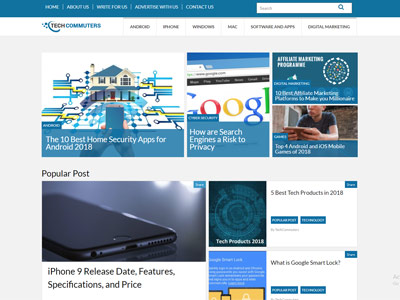The Best tech blog: Your Essential Overview to Browsing the Digital World
The Best tech blog: Your Essential Overview to Browsing the Digital World
Blog Article
Recognizing the Increase of Edge Computing in Today's Digital Globe
In the quickly advancing landscape of technology, edge computer arises as a crucial pressure, reshaping just how information is refined and utilized. By transitioning data management closer to the resource, side computer addresses crucial latency problems while enhancing bandwidth usage and enhancing safety and security actions.
What Is Side Computing
Edge computing, although a reasonably recent innovation in the realm of modern technology, basically changes exactly how information is processed and taken care of by bringing computation and information storage closer to the location where it is needed. Unlike typical cloud computer designs, which typically depend on centralized information facilities that can be geographically far-off, side computing decentralizes information handling. This closeness reduces latency, improves real-time information handling, and enhances the total user experience by ensuring quicker reaction times.
At its core, side computing entails a network of local tools and framework, such as sensing units, portals, and routers, capable of processing data at or near the resource. This localized handling capability is specifically important for applications needing prompt information evaluation, such as independent lorries, commercial automation, and clever cities. Furthermore, by offloading information processing jobs from central web servers, side computer lowers bandwidth demands and improves information personal privacy and safety and security, as sensitive information can continue to be on-site as opposed to going across substantial networks.

Trick Motorists of Fostering
Numerous variables are pushing the adoption of edge computing in today's digital landscape. Side computing addresses this requirement by making it possible for data processing closer to the information source, lowering latency and enhancing real-time decision-making capabilities.
Another substantial vehicle driver is the need for improved transmission capacity efficiency. Centralized cloud systems can become overwhelmed with the sheer volume of data created by IoT gadgets, leading to bottlenecks (Best tech blog). By processing data at the edge, companies can relieve network blockage and boost total system efficiency
In addition, safety and security and personal privacy concerns are pressing organizations toward side computing. By refining delicate data locally, business can minimize risks linked with data transmission and exposure to prospective cyber dangers.
The increase of applications requiring real-time handling, such as independent cars and augmented truth, additionally demands the quick reaction times that border computing gives. Jointly, these drivers are making side calculating an indispensable element of modern IT facilities, leading the way for its widespread fostering across various markets.
Benefits Over Cloud Computer
Just how does side computer distinguish itself from typical cloud computing? Mostly, edge computing brings information handling closer to the source of information generation, typically on close-by web servers or neighborhood devices, instead of depending on centralized information centers. This closeness dramatically decreases latency, allowing real-time data processing and decision-making. For sectors where milliseconds issue, such as self-governing lorries or industrial automation, the reduced latency offered by edge computing can be crucial.
Moreover, side computer boosts transmission capacity efficiency (Best tech blog). By processing information locally, only the required information is sent to the cloud for more evaluation or storage space, minimizing the volume of data that goes across the network. This not only alleviates network congestion but additionally reduces data transmission prices
Edge computing also uses better data personal privacy and security. Sensitive data can be processed in your area without being sent to the cloud, decreasing the exposure to potential cyber hazards. This is especially advantageous for fields managing private info, such as healthcare and economic services.
Moreover, edge computing makes certain better resilience and dependability. Regional processing enables for proceeded procedure also when connectivity to the cloud is jeopardized, maintaining important functions and solutions in spite of possible network disruptions. These advantages collectively show side computing's transformative possibility in enhancing efficiency and safety and security in digital ecological communities.
Factors To Consider and difficulties
While edge computing provides numerous benefits, it also presents special difficulties and factors to consider that need to be resolved to totally understand its capacity. One substantial difficulty is data safety and personal privacy. Processing information better to the source boosts the risk of unapproved accessibility, requiring robust file encryption and rigorous safety procedures to safeguard sensitive info. Furthermore, managing and monitoring a decentralized network of edge tools can be intricate, needing sophisticated tools and strategies to make sure smooth operation and upkeep.
One more consideration is the scalability of edge computer solutions. As the number of linked tools expands, so does the demand for processing power at the edge, which can lead to source constraints. Organizations should thoroughly plan their facilities to accommodate this development without jeopardizing efficiency or performance.
Interoperability is one more vital element. With various software and hardware parts entailed, making sure compatibility and seamless integration can be difficult. Standardization efforts are necessary to facilitate interaction between disparate systems.
Future Trends in Side Computer
Anticipating the future, side computer is positioned to change numerous industries by enabling check these guys out quicker data processing and reducing latency. As the quantity of information created by IoT devices remains to grow, edge computer will certainly become significantly crucial official statement in handling this increase successfully. One substantial trend is the integration of expert system at the edge, permitting real-time analytics and decision-making without counting on cloud-based resources. This change is prepared for to boost applications in autonomous cars, wise cities, and health care, where prompt information handling is important.
Another emerging fad is the development of edge-native applications developed especially to take advantage of the distinct capacities of side computer. These applications will optimize performance and resource utilization, bring about enhanced efficiency throughout various markets. Innovations in 5G innovation will additionally bolster edge computing by giving the essential infrastructure for high-speed, low-latency communication in between tools and edge nodes.
Verdict
Side computing's rise is driven by the spreading of IoT gadgets and the requirement for real-time data handling, which enhances efficiency by reducing latency and decentralizing information monitoring. This technique alleviates bandwidth ineffectiveness and safety and security concerns, helping with advancements in applications like smart cities and autonomous cars. Despite difficulties such as infrastructure complexity and integration, the future of edge computer guarantees an extra responsive electronic ecosystem, with proceeded technologies forming its advancement and increasing its applicability throughout markets.
Side computer, although a reasonably recent development in the realm of technology, fundamentally changes how information is refined and handled by bringing calculation and data storage space closer to the area where it is needed. Unlike typical cloud computer versions, which commonly count on central information centers that can be geographically distant, side computer decentralizes information handling. Furthermore, by unloading information handling jobs from main servers, side computing lowers bandwidth requirements and improves data privacy and protection, as delicate details can stay on-site instead than going across considerable networks.

Report this page